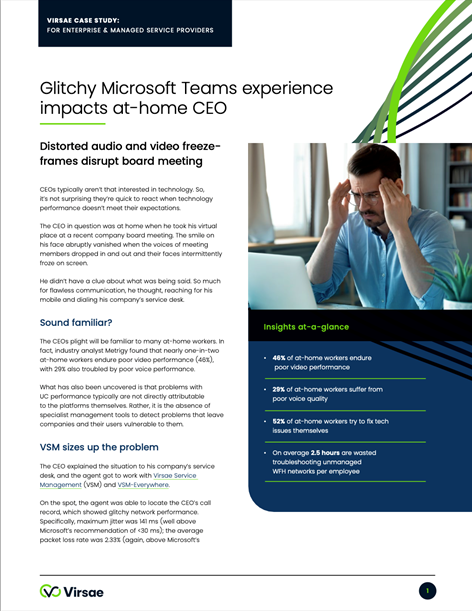Download this article as a sharable PDF
Distorted audio and video freeze-frames disrupt board meeting
CEOs typically aren’t that interested in technology. So, it’s not surprising they’re quick to react when technology performance doesn’t meet their expectations.
The CEO in question was at home when he took his virtual place at a recent company board meeting. The smile on his face abruptly vanished when the voices of meeting members dropped in and out and their faces intermittently froze on screen.
He didn’t have a clue about what was being said. So much for flawless communication, he thought, reaching for his mobile and dialing his company’s service desk.
Sound familiar?
The CEOs plight will be familiar to many at-home workers. In fact, industry analyst Metrigy found that nearly one-in-two at-home workers endure poor video performance (46%), with 29% also troubled by poor voice performance.
What has also been uncovered is that problems with UC performance typically are not directly attributable to the platforms themselves. Rather, it is the absence of specialist management tools to detect problems that leave companies and their users vulnerable to them.
VSM sizes up the problem
The CEO explained the situation to his company’s service desk, and the agent got to work with Virsae Service Management (VSM) and VSM-Everywhere.
On the spot, the agent was able to locate the CEO’s call record, which showed glitchy network performance. Specifically, maximum jitter was 141 ms (well above Microsoft’s recommendation of <30 ms); the average packet loss rate was 2.33% (again, above Microsoft’s recommendation of <1%); and the maximum packet loss rate was 97.98% (a reasonable amount of maximum packet loss could be 5-8%).
These insights confirmed the existence of a problem – or at least the size and scope of its symptoms. However, fixing the problem required the agent to identify its root cause.
Locating root cause
A defining feature of VSM is the ability to collect data from XCaaS solution components, everywhere they are deployed, including remote workstations beyond the enterprise network, courtesy of VSM Everywhere (a software agent deployed on user devices).
With the CEO still on the line, the service desk agent was able to assess his device – HP EliteBook 840 G3 laptop, running Windows 10 Enterprise and an Intel(R) Dual Band Wireless-AC 8260 – and confirm that all drivers were up to date.
At 5 GHz, the Wi-Fi speed for the meeting call was passable, though in the lower range.
The Wi-Fi signal strength was -77dB – 10dB below the required minimum value of -67 dB – providing the first big clue. At 46, the link quality (Signal-to-Noise Ratio) was below the minimum recommended value of 50, indicating Wi-Fi contention from nearby Wi-Fi-connected devices.
VSM’s machine learning indicated that these two factors in unison compound to create a poor user experience. In short, the CEO’s Wi-Fi home network was at the root of his problem. The service desk agent offered the following advice:
- Use a wired connection between his router and laptop, or simply move closer to the Wi-Fi router
- If these two actions were out of the question, he could try connecting to the 2.4 GHz SSID, as previous interactions recorded in VSM showed consistently good quality when 2.4 GHz was used on his home network
Back on track
The CEO relocated to the kitchen bench, closer to his household’s router. The difference was immediate and he ‘re-joined’ the meeting.
So often service agents operate without this insight, at best promising to get back to aggrieved users once they’ve had the chance to install troubleshooting software and pore over logs in the hope of locating the problem.
VSM is ‘always-on’, providing the complete picture of XCaaS platform performance to service desk agents, so they can immediately diagnose and act decisively with at-a-glance views of applications, communications systems, networks, ISPs, ‘unmanaged’ home environments, and AV devices.

